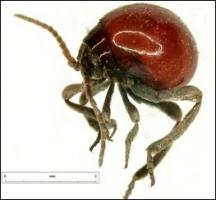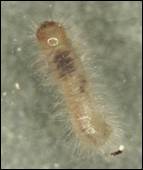Adult
Size
2 to 5 mm long
Aspect
Sturdy 11-articled antennae.
Elytra are smooth and shiny, and they nearly completely cover the abdomen.
Legs covered in golden bristles.
Colour
Bright hues, ranging from red to dark brown.

Gibbium longicorne Reitter, 1884
 Ptine bombé
Ptine bombé  Spider beetle Northern Ptinus
Spider beetle Northern Ptinus  Escarabajo araña lustroso
Escarabajo araña lustroso  Kugelkäfer
Kugelkäfer Up to recently, Gibbium psylloides belonged to the Ptinidae family, but Ptinidae have now been included into the Anobiidae family. These inconspicuous insects, which shy away from light, rather thrive in quiet, dark places of warehouses and houses (attics, barns, cellars). Thanks to their smooth, shiny, round-shaped aspect, they are highly characteristic and easily recognisable.
Adults are sometimes mistaken for small spiders, but the difference between them can easily be told thanks to their 3 pairs of legs (Arachnidae have 4 pairs of legs) and to their antennae.
Gibbium psylloides cannot fly for their elytra are sealed together, and they move around rather slowly. They feed on dry organic debris of plant or animal oroigin. They can cause fairly important damage in fabrics and books, and minor damage in stored foodstuffs. Yet the damage they cause is considered as reaching a lesser extent than the damage caused by related species. They get adapted to cool climates quite easily and they can survive without food for long periods of time; adults can live up to 1 year. Some Hymenoptera belonging to the Bethylidae family can infest their larvae.

2 to 5 mm long
Sturdy 11-articled antennae.
Elytra are smooth and shiny, and they nearly completely cover the abdomen.
Legs covered in golden bristles.
Bright hues, ranging from red to dark brown.

4mm.
Look like small, rather soft, slightly curved grubs, with a pubescence of yellowish erect bristles on their entire body.
Pinkish white, with a brown head.
The biology of the species is quite similar to that of other Anobiidae.
The full cycle requires an average 12 to 16 weeks in normal conditions, and only 7 weeks in optimal conditions at 30°C.
Females lay 50 to 100 eggs, usually in late spring or in summer, which hatch 2 weeks after being laid.
Larval development lasts about 6 weeks, nymphosis lasts 3 to 4 weeks. There are 3 or 4 generations per year.
Stuffed animal collections can be devastated by Gibbium psylloides, along with fabrics where infestation can de detected thanks to the presence of small holes bored by the larvae. Books and leather book-bindings are quite appreciated by that species, which causes less damage in collections than the library beetle.
Its food is mainly composed of plant debris (seeds, flour, spices, herbs, cocoa, synthetic silk, or even opium) and of organic debris now and then. Spider beetles have even been found in Egyptian mummies in museums.
The country spider beetles originally came from is not known, for it has been moving about since men started trading.
It is now distributed nearly worldwide. In France, it is fairly common.
